Key takeaways:
- Engaging game lessons coupled with competition and collaboration enhance student motivation and learning experiences.
- Interactive learning caters to diverse educational needs, fostering deeper connections among students and improving retention of information.
- Incorporating technology, such as interactive quizzes and virtual reality, creates immersive, exciting learning environments.
- Feedback and reflection are essential for continuous improvement in lesson planning and teaching strategies.
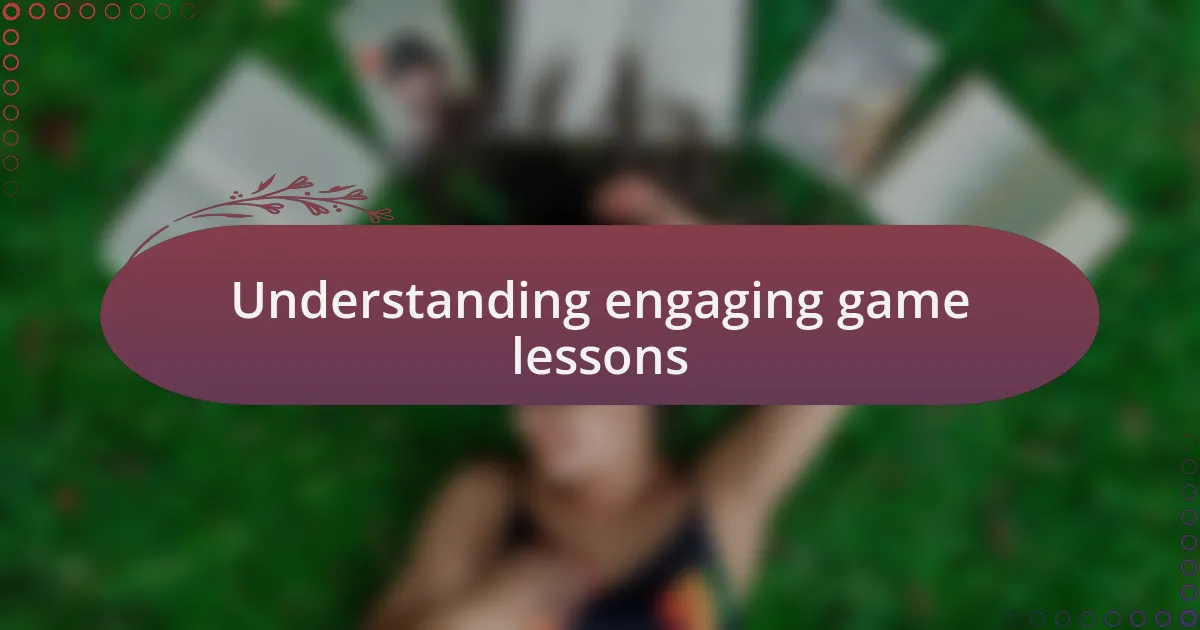
Understanding engaging game lessons
Engaging game lessons are all about creating a dynamic learning environment that captivates students’ attention. I remember a time when I introduced a simple trivia game to review a complex topic. The excitement in the room was palpable; students were not only competing but also collaborating to solve problems, which made the learning experience so much richer.
One essential aspect of these lessons is the element of challenge. Have you ever noticed how a little competition can spark motivation? I once incorporated a race against the clock into a mathematics lesson. Students were practically buzzing with energy as they worked in teams, helping each other navigate through problems. It wasn’t just about the scores; it fostered a sense of camaraderie.
Another layer to consider is the relevance of the game content to students’ everyday lives. I often ask myself, “How can I connect this learning to their interests or experiences?” For instance, using a popular video game theme to teach history can ignite students’ imaginations and make facts come alive in a way that textbooks never could. Engaging game lessons should not only educate but also resonate emotionally with students, making them feel that learning is not just a task, but an adventure.
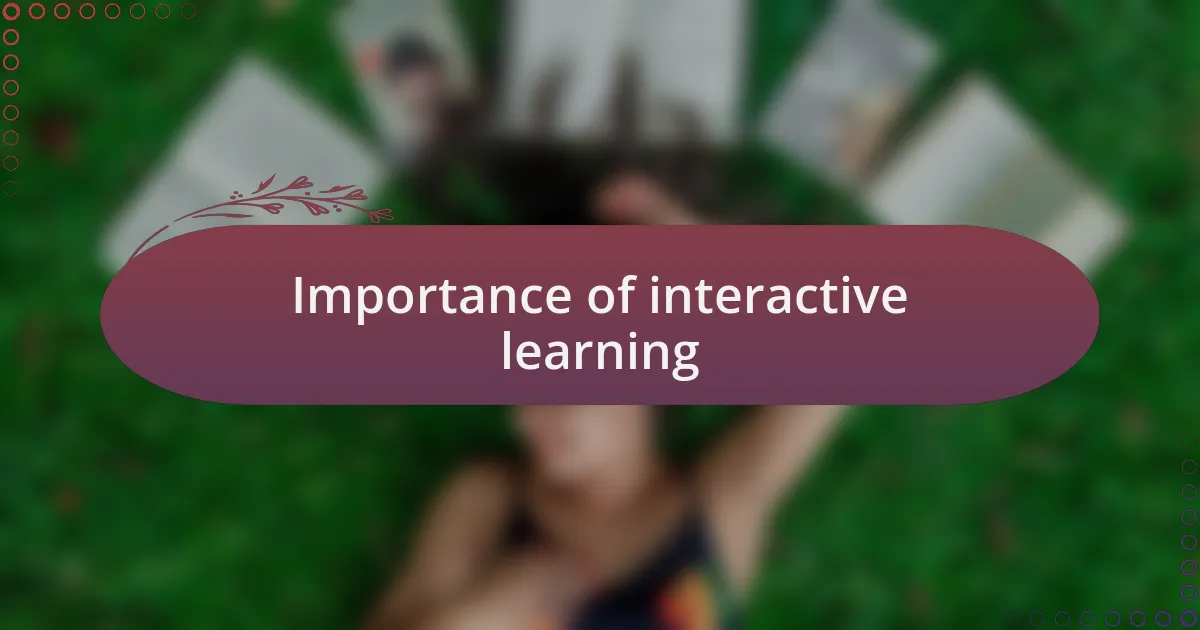
Importance of interactive learning
Interactive learning is a cornerstone of modern education. I recall a workshop where we transformed traditional lectures into hands-on activities. The shift was remarkable; students who once sat quietly began to engage deeply, their eyes lighting up as they tackled challenges. It made me realize that when learners can touch, manipulate, and discuss ideas, they’re more likely to absorb and retain information.
Think about how interactive methods engage different learning styles. For instance, I once had a visual learner who struggled with abstract concepts. By incorporating digital simulations into the lesson, he not only grasped the material but also became an advocate for interactive learning among his peers. It was a powerful reminder that these methods can cater to diverse needs and make everyone feel included in the educational process.
Moreover, the social aspect of interactive learning cannot be ignored. I remember a group project where students had to collaborate and present their findings creatively. The laughter, discussions, and occasional disagreements only deepened their connections to the material and to each other. Isn’t it fascinating how learning becomes a shared experience? When students work together, they build not just knowledge but also essential social skills that last a lifetime.
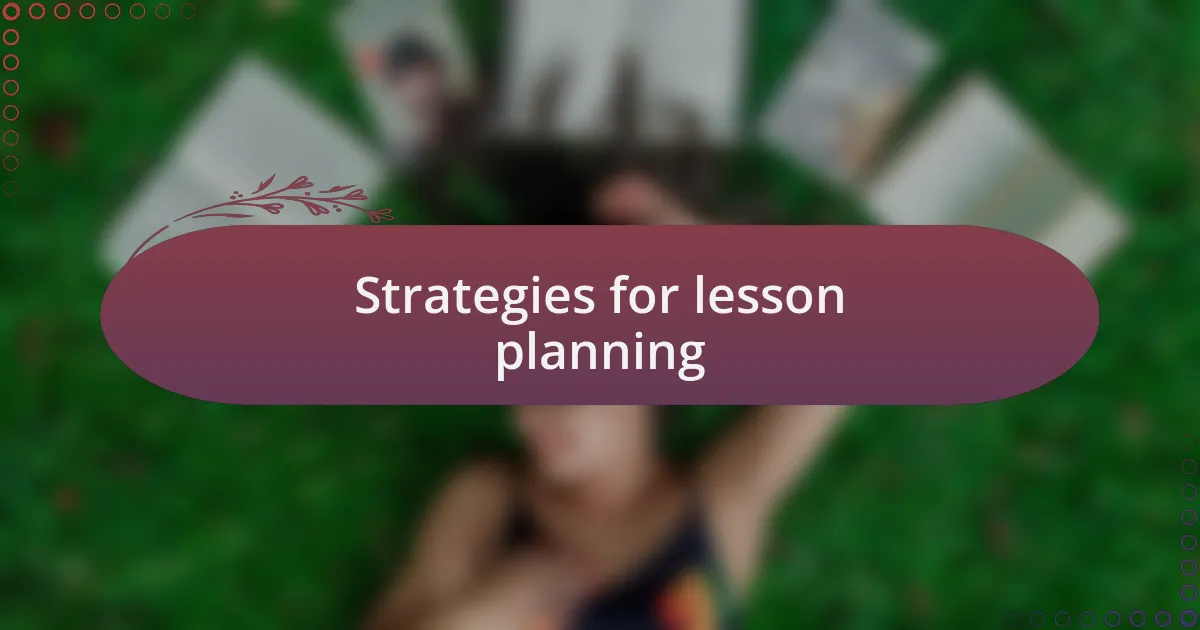
Strategies for lesson planning
Planning lessons can feel overwhelming, but incorporating clear objectives can truly streamline the process. I vividly remember a time when I spent hours crafting a lesson without clear goals, only to realize halfway through the class that my students were lost. By setting specific, measurable outcomes beforehand, I found that it not only focused my teaching but also kept my students motivated. Have you ever noticed how clarity in expectations can energize the classroom?
Another effective strategy is to integrate a variety of materials. I’ve experimented with using videos, articles, and hands-on activities in my lessons. For example, after introducing a complex topic through a brief documentary, I followed up with a group activity that allowed students to explore the concept practically. This combination kept the energy high and fostered richer discussions. It’s like mixing colors on a palette; the more diverse your materials, the richer the learning experience.
Finally, being flexible in your plans can lead to unexpected learning outcomes. Once, I prepared a lesson that went completely off the rails because students had intriguing questions that took us in a new direction. Instead of resisting, I leaned into that curiosity. We ended up having a deeper conversation that was far more valuable than what I had initially planned. Isn’t it amazing how spontaneity can sometimes lead to the most memorable lessons? Embracing those moments can transform both your teaching and your students’ learning journeys.
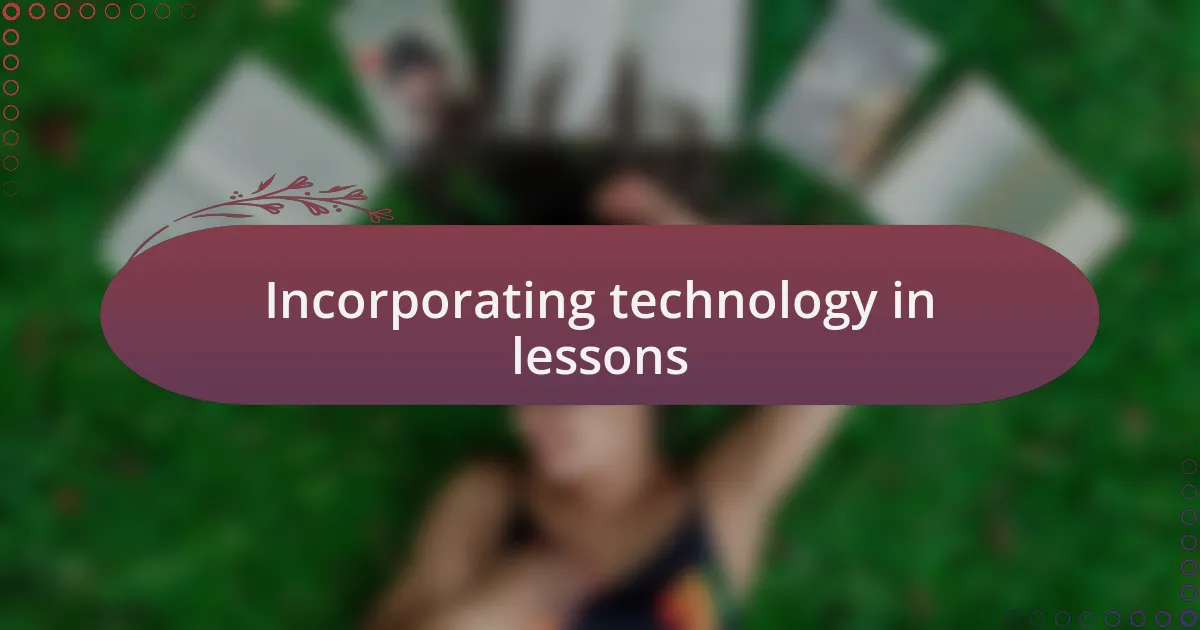
Incorporating technology in lessons
Incorporating technology in lessons can truly elevate the learning experience. I recall a time when I introduced an interactive quiz tool during a review session. It was fascinating to see my students light up as they answered questions in real-time, competing against each other while reinforcing their knowledge. Can you feel that buzz of excitement when technology bridges the gap between learning and fun?
During one lesson, I decided to use a virtual reality app to transport my students to ancient civilizations. Watching their eyes widen as they “walked” through the streets of Rome was unforgettable. It struck me how immersive experiences can foster a deeper connection to the material. Have you ever seen a student become so engaged that they forget they’re even learning? It’s moments like these that make me appreciate the potential of technology in education.
Furthermore, I often use collaboration tools like Google Docs for group projects. It amazed me how seamless it was for students to work together, even outside of class hours. One group synthesized their findings into a presentation effortlessly, blending ideas and creativity. This experience led me to realize—how often do we underestimate the power of technology to facilitate teamwork and innovation in our classrooms? Embracing these tools not only enhances learning but also prepares students for the collaborative environments they will encounter in their futures.
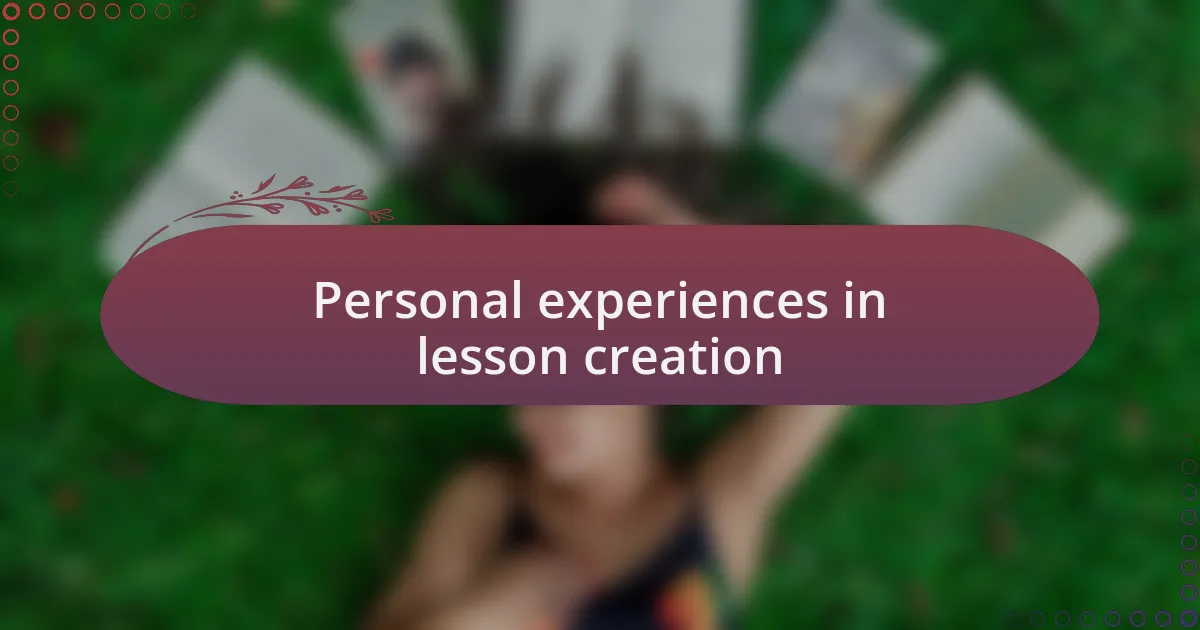
Personal experiences in lesson creation
Creating engaging lessons feels like an art form for me. I remember a particular project where I transformed a simple math lesson into a treasure hunt that spanned the entire school. Students raced from one clue to the next, solving problems to uncover the next location. Watching their faces light up as they collaborated and problem-solved outside the traditional classroom was exhilarating.
One experience that stands out involved designing a science lesson around a hands-on experiment. We built simple rockets and launched them in the schoolyard. The sheer joy and surprise on the students’ faces as their rockets soared into the sky were priceless. It made me think: do we often limit learning to the classroom walls? The thrill of discovery outside those walls can ignite a passion for learning that sticks with students long after the lesson ends.
I’ve also experimented with themed lessons, where I dress up and immerse students in a historical narrative. During a World War II unit, I came in wearing period-appropriate attire and used storytelling to bring the time period to life. The awe in my students’ eyes made it clear that my efforts fostered a rich connection to the subject matter. Isn’t it interesting how a simple change in presentation can radically transform student engagement? It’s these moments that remind me how vital it is to make lessons dynamic and memorable.
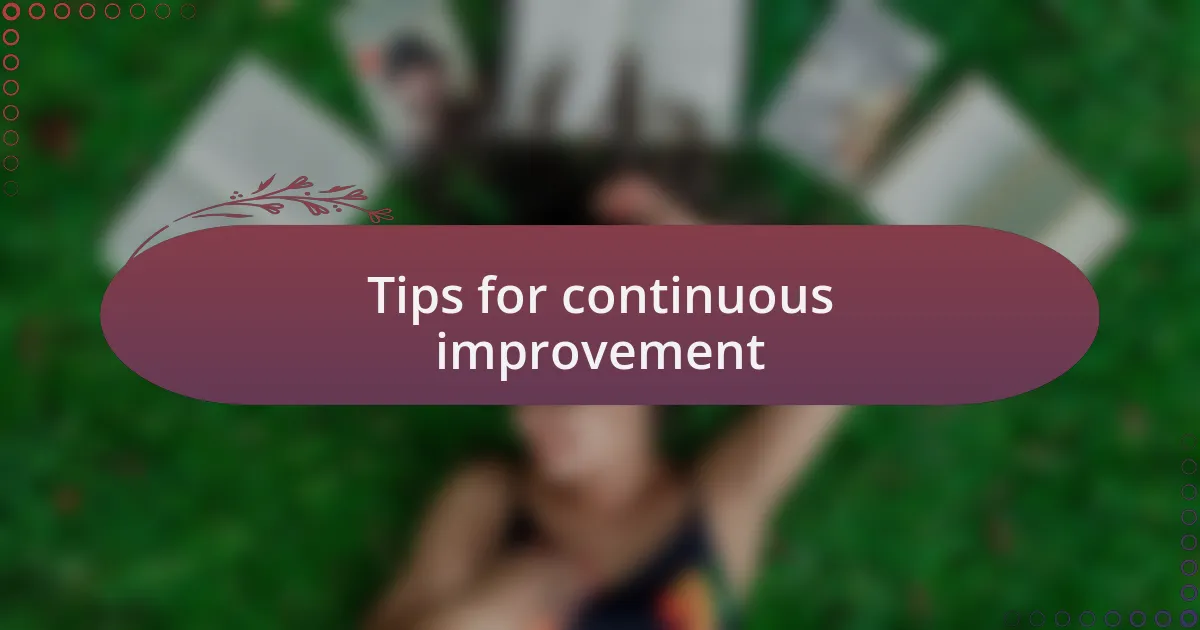
Tips for continuous improvement
One fundamental tip for continuous improvement is to seek feedback from students. I often find it enlightening to ask my students for their thoughts on a lesson after we’ve wrapped up. This could be as simple as a quick exit ticket where they share what they enjoyed or found challenging. Their insights can reveal gaps I might not see and spark ideas for future lessons. Have you ever noticed how valuable student perspectives can be in shaping your teaching approach?
Another approach I’ve adopted is reflecting on each lesson’s outcomes. After a lesson, I set aside a few minutes to jot down what worked well and what didn’t, along with my emotional responses during the activity. For example, I once realized that while my lesson on ecosystems was engaging, I hadn’t catered enough to different learning styles. It struck me how crucial it is to be aware of our own effectiveness as educators. Don’t you feel that cultivating this habit can significantly enhance our ability to adapt and innovate?
Lastly, I encourage collaboration with fellow teachers. Establishing a supportive network of colleagues can provide fresh perspectives and shared resources. I recall a time when a peer shared a unique game-based learning strategy that transformed my approach to teaching literature. Engaging in discussions with others can illuminate new techniques and methodologies. Isn’t it amazing how the collaborative spirit can lead to more enriched educational experiences for our students?